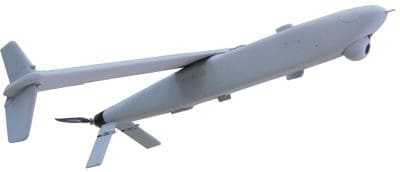This post is also available in:
 עברית (Hebrew)
עברית (Hebrew)
By Arie Egozi
The war between Azerbaijan and Armenia is already dubbed “the first loitering systems war”. And to that one should add “Israeli-made loitering systems.”
What until some years ago was considered a “luxury” item for a fighting unit, is now almost a baseline demand. Loitering weapon systems are in high, very high demand and the Israeli defense industries are working hard to provide that demand.
It can be said without any doubt that the “big leap” started some five years ago. Until that time the only operational loitering weapon system made in Israel was the Harop, developed by Israel Aerospace Industries (IAI). According to video footage from the war zone in eastern Europe, the Harop has been used by Azerbaijan.

The Harop has been developed to destroy high-quality targets.
It consists of the munitions unit, transportable launcher and a mission control shelter, which provides real-time access to control the Harop by a man-in-the-loop.
The Harop can be launched from various transportable platforms including sea and ground-based canisters or air-launched to navigate towards the potential target area. It can be launched at any angle, horizontal or at a vertical trajectory. The sealed container ensures protection from harsh battlefield conditions.
The Harop is armed with a 16 kg warhead and is equipped with a very advanced day/night payload (POP-250) made by the Tamam division of IAI.
Two years ago IAI unveiled the Mini Harpy, based on two older systems the Harpy and the Harop.
The Mini Harpy has a dual sensor – EO and Electromagnetic.
While IAI’s main loitering weapon systems are the massive Harop and the down sized mini Harpy, the company has developed systems for small units on the move.
One is the ‘Green Dragon’. This tube/canister-launched drone is designed for the battalion and brigade levels.
It weighs only 33 pounds and uses a small EO payload for a seeker. Its warhead weighs only 5.5 pounds. Despite its small size, it is highly useful against most tactical targets. “Green Dragon” can loiter for 1.5 hours at distances of 24 miles from the control point. The launch tubes can be carried in a backpack, or stack on vehicular launchers, in groups 12-18.

Three years ago, IAI unveiled a new personal loitering munition system. The system is dubbed “Rotem” and weighs 10 pounds.
The VTOL system is powered by electric motors operating 4 rotors
It carries an interchangeable day/ night payload
The “Rotem” is armed with two hand grenade size explosive units.

The company says that the system is aimed at serving units in urban fighting and that it can be controlled to “get through a window.”
The system has an endurance of 30-45 minutes and a soldier can carry 3-4 such systems and control them by using a tablet-sized control unit.
The system is also equipped with an acoustic sensor to avoid collision with obstacles in the area of operation.
It is operated by a single soldier using a simple point and click commands on a tablet controller, similar to the one operating the Green Dragon.
When it became clear that there is a big market for loitering weapon systems, other Israel companies joined the effort.
Four years ago, Raytheon teamed with Israeli company UVision in an attempt to get orders to supply the Israeli developed Hero-30 loitering weapon system to the U.S special forces command under the U.S army’s lethal miniature aerial missile systems (LMAMS) tender expected in the coming months.
The tender is aimed at the purchase of 25.000 loitering weapon systems in a 15 year period.
According to the contract, if the Hero-30 is selected, Raytheon will serve as the main contractor.
The special derivative of the Hero-30 loitering weapon system developed by Israeli company UVision will be lighter and will carry a smaller warhead but will be capable of hitting the target very accurately.
The current version of the Hero-30 weapon system weighs 6.5 pounds armed with a 1 pound warhead. It is carried in a canister that is also used as a pneumatic launcher. After launch, the electric motor is turned on.
The Hero-30 is equipped with a day/night sensor and has an endurance of 30 minutes.
After the Hero-30 is launched it locks on the predesigned target and transmits the video to the operator using a handheld unit.
The Hero-30 is loitering in altitudes between 980 and 2000 feet above the ground. The data link that was developed for the system can control it in ranges of 6 or 24 miles, depending on the antenna used.
Aeronautics, the Israel UAS manufacturer has also joined the development effort and unveiled its new loitering weapon system the Orbiter 1K.
The Orbiter 1K is based on the structure and properties of the company’s Orbiter 2. This is the first time Aeronautics is developing a loitering system.
According to the Israeli company, the Orbiter 1K is launched from a catapult, and can fly for 2-3 hours, carrying a multi-sensor camera with day-and-night channels. The loitering system is compact and easily controlled from a personal GCS.
Aeronautics says that given a specific waypoint, the loitering Orbiter 1K can detect and destroy a moving or a stationary target. The system can also operate on the base of a given area range: the Orbiter 1K independently scans the area, detects and destroys the target – moving or stationary. In case the target wasn’t detected or in any change of plans, the system’s recovery capability allows it to return to its base camp and land safely using a parachute and an airbag.
Aeronautics says that the 1K can get to its designed target by preloaded waypoints or using its optical sensor.
The Israeli company says that the system has a shoot and forget mode but if the target – moving or stationary, is not detected, the ground operator can bring it back to a safe landing.
The system has an endurance of 30-45 minutes and a soldier can carry 3-4 such systems and control them by using a tablet size control unit.
The system is also equipped with an acoustic sensor to avoid collision with obstacles in the area of operation.
It is operated by a single soldier using a simple point and click commands on a tablet controller, similar to the one operating the Green Dragon.
The war between Azerbaijan and Armenia is without any doubt a turning point as related to loitering weapon systems.

Arie Egozi, iHLS Editor-in-Chief


























